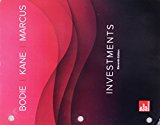
a
To compute: The annual
Introduction:
Rate of
a
Explanation of Solution
Given Information:
Expense ratio = 0.5%
Mutual Fund = 4% load
Bank CD interest = 6%
There is another option for investing i.e., investment in Bank CD (Certificate of Deposit). So, better option for investment is has to be analyze- whether investing in mutual funds is better or in Bank CD. In case option mutual funds is chosen, then it should be ensured that it provides rate of return more than any bank CD. Normally a mutual fund requires front-end load and this adversely reduces the net value investment amount. Further the investor has to shell down the expense ratio also on this investment. So, to balance the rate of return of bank CD and the mutual fund, the following calculation will be helpfully.
where r= rate of return
t=number of period
Now depict the values in the equation and proceed with the calculation:
We can rewrite the equation as :
So,
Converting the above value into percentages
= 8.69%
Therefore, the mutual fund portfolio will be better than Bank CD if it earns more than 8.69% per annum.
The mutual fund portfolio will be better than Bank CD if it earns more than 8.69% per annum.
b
To compute: The annual rate of return when the plan of investment is for 6 years.
Introduction:
Investment: When an individual deposit or does an act of investing his money for profit, it is called investment. Investments can be for short term and long term.
b
Explanation of Solution
Given Information:
Expense ratio = 0.5%
Mutual Fund = 4% load
Bank CD interest = 6%
To calculate the rate of return to balance the return earned on investment in mutual fund with than of Bank CD when the investment is made for 6 years. The formula to be used for this computation is as follows:
Where ‘r’ = rate of return
‘t’ = number of period
Now let us depict the values in the equation and proceed with the calculation:
The equation can be written as :
So,
Or 7.22%.
Therefore, the mutual fund portfolio will be better than Bank CD if it earns more than 7.22% per annum.
Incase, the investor decides to hold the investment in mutual fund for 6 years, then the mutual fund portfolio will be better than Bank CD if it earns more than 7.22% per annum.
c
To compute: The annual rate of return of the Mutual Fund portfolio in case there is no front-end load and 12b-1 fee of 0.75% per year is utilized.
Introduction:
Mutual Funds: It is a type of investment which can be done even by individual investors and can be managed at a low price. It consists of portfolio of stocks, bonds and other types of securities.
c
Explanation of Solution
Given Information:
Expense ratio = 0.5%
12b-1 fee= 0.75%
Bank CD interest = 6%
Like in previous cases, here we are not considering (1-Front-end load) calculation as there is no front-end load and instead we will use 12b-1 fee. So the formula will be as follows:
where r= rate of return
t=number of period
Now let us depict the values in the equation and proceed with the calculation when the investment is made for 2 years.
We can rewrite the equation as :
So,
When we convert the above value into percentages we get 7.25%
Therefore, the mutual fund portfolio will be better than Bank CD if it earns more than 7.25% per annum.
The same calculation has to be done when the investment is made for 6 years.
where r= rate of return
t=number of period
Now substitute the values in the formula
We can rewrite the equation as :
So,
When we convert the above value into percentages we get 7.25%
Therefore, the mutual fund portfolio will be better than Bank CD if it earns more than 7.25% per annum.
Given the situation where investment is made for 2 years and 6 years, the mutual fund portfolio will be better than Bank CD if it earns more than 7.25% per annum in the both cases.
Want to see more full solutions like this?
Chapter 4 Solutions
GEN COMBO LOOSELEAF INVESTMENTS; CONNECT ACCESS CARD
- critically discuss the hockey stick model of a start-up financing. In your response, explain the model and discibe its three main stages, highlighting the key characteristics of each stage in terms of growth, risk, and funding expectations.arrow_forwardSolve this problem please .arrow_forwardSolve this finance question.arrow_forward
- solve this question.Pat and Chris have identical interest-bearing bank accounts that pay them $15 interest per year. Pat leaves the $15 in the account each year, while Chris takes the $15 home to a jar and never spends any of it. After five years, who has more money?arrow_forwardWhat is corporate finance? explain all thingsarrow_forwardSolve this finance problem.arrow_forward
 Essentials Of InvestmentsFinanceISBN:9781260013924Author:Bodie, Zvi, Kane, Alex, MARCUS, Alan J.Publisher:Mcgraw-hill Education,
Essentials Of InvestmentsFinanceISBN:9781260013924Author:Bodie, Zvi, Kane, Alex, MARCUS, Alan J.Publisher:Mcgraw-hill Education,

 Foundations Of FinanceFinanceISBN:9780134897264Author:KEOWN, Arthur J., Martin, John D., PETTY, J. WilliamPublisher:Pearson,
Foundations Of FinanceFinanceISBN:9780134897264Author:KEOWN, Arthur J., Martin, John D., PETTY, J. WilliamPublisher:Pearson, Fundamentals of Financial Management (MindTap Cou...FinanceISBN:9781337395250Author:Eugene F. Brigham, Joel F. HoustonPublisher:Cengage Learning
Fundamentals of Financial Management (MindTap Cou...FinanceISBN:9781337395250Author:Eugene F. Brigham, Joel F. HoustonPublisher:Cengage Learning Corporate Finance (The Mcgraw-hill/Irwin Series i...FinanceISBN:9780077861759Author:Stephen A. Ross Franco Modigliani Professor of Financial Economics Professor, Randolph W Westerfield Robert R. Dockson Deans Chair in Bus. Admin., Jeffrey Jaffe, Bradford D Jordan ProfessorPublisher:McGraw-Hill Education
Corporate Finance (The Mcgraw-hill/Irwin Series i...FinanceISBN:9780077861759Author:Stephen A. Ross Franco Modigliani Professor of Financial Economics Professor, Randolph W Westerfield Robert R. Dockson Deans Chair in Bus. Admin., Jeffrey Jaffe, Bradford D Jordan ProfessorPublisher:McGraw-Hill Education





